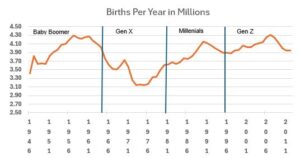The Charmed Life Cycle of Baby Boomers
After the deprivation and rationing of the Great Recession and Second World War, Americans looked with optimism toward a future of peace and prosperity. The country entered a period of plentiful jobs, increasing wages, and factories converted from wartime production to a variety of household goods. Feeling a sense of confidence that they would be able to afford children, people no longer put off marriage. With nearly 90 percent of men in the labor force but only one-third of women, the family of a working father and a stay-at-home mother became the norm. While many African American and elderly citizens continued to live in poverty, the vast majority of families enjoyed unparalleled prosperity.
 The U.S. recorded 2.9 million births in 1945 and 3.4 million in 1946. In 1954 births exceeded 4 million for the first time and remained above that level for the next ten years. So began the 1946-1964 Baby Boom. Manufacturers and advertisers quickly realized the opportunities offered by this gigantic demographic bulge. Diapers and washing machines were immediate necessities. Baby and toddler clothes, high chairs, toys, swing sets, school supplies, hula hoops, Barbie dolls, to name a few, satisfied the needs of the rapidly growing population. (Click to enlarge photo.)
The U.S. recorded 2.9 million births in 1945 and 3.4 million in 1946. In 1954 births exceeded 4 million for the first time and remained above that level for the next ten years. So began the 1946-1964 Baby Boom. Manufacturers and advertisers quickly realized the opportunities offered by this gigantic demographic bulge. Diapers and washing machines were immediate necessities. Baby and toddler clothes, high chairs, toys, swing sets, school supplies, hula hoops, Barbie dolls, to name a few, satisfied the needs of the rapidly growing population. (Click to enlarge photo.)
A 1958 Life Magazine article titled “Rocketing Births: Business Bonanza,” estimated annual expenditures on products and services for baby boom families. In 2024 dollars, $58 million was spent on bronzed baby shoes, a 1950s must-have; $579 million on diaper services; $14.5 billion on toys; and governments spent $29 billion on 62,600 new classrooms.
By 1960 ninety percent of U.S. households had television, and families throughout the country watched the same three channels with the same news programs and the same popular family shows: Leave it to Beaver, Father Knows Best, Ozzie and Harriet. “By some estimates, children raised on shows like The Mickey Mouse Club and Howdy Doody saw more than 500 hours of ads by the age of 6.” And they bought mouse-ear hats to wear while they watched.
Shortly after the 1958 Life Magazine issue came out, marketers discovered baby boomer teenagers. One marketer estimated that teenagers spent the equivalent of $116 billion a year on products in the late 1950s. That included $232 million on lipstick and $869 million on pop records. Weekly allowances and first jobs financed first cars and stylish clothing. Rock music of the 1960s was emblematic of a youthful counterculture for participants who “rejected many of the social, economic, and political values of their parents’ generation; they initiated a sexual revolution and introduced greater informality into U.S. culture.” Student activists organized demonstrations against the war in Vietnam on college campuses.
(Click to enlarge chart.)
Births between 1965 and 1980 are referred to as Generation X. Births hit a low point of 3.14 million in the mid-1970s. As the baby boomers started families, they created an “echo boom” in population, with a 1990 peak of 4.16 million births. Growing up during a period of significant social change, baby boomers as parents tended toward a structured style of discipline and focus on education and hard work. The echo boom of 1981-1996 created the generation that came to be known as millennials.
Today baby boomers are in their 60s and 70s. As they become grandparents, have they become less relevant to the economy? Hardly! “Now, as older adults and retirees with waning obligations and a lot of disposable cash, boomers continue to hold a significant chunk of American wealth and the consumer power that goes with it — and in turn, products and services for boomers have proliferated.” Travel – if health allows, financial planning, long-term care, modifying homes for aging in place, learning to use technology. For less active individuals, new options might include armchair travel, urban hiking, or an elderly version of the “The Y” – Young Men’s Christian Association (YMCA), call it the Old Men’s Christian Association – “The O.”
A columnist for the St Louis Post-Dispatch wrote that he is at an awkward age, too old to work, but too young to run for president.
See you baby boomers at “The O.”

